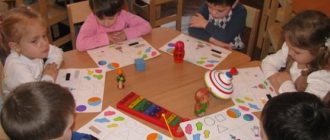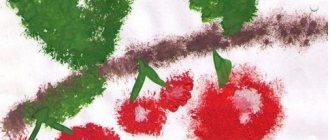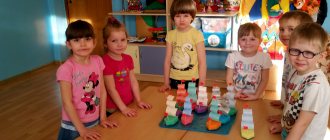How to design a fabric collection
Anna Sokolova
How to design a fabric collection
A collection of fabrics should be present in the developmental environment of each group. And I racked my brain for a long time on how to make it look beautiful, affordable and durable.
For work, I needed samples of different fabrics measuring 19*19 cm, cardboard, names of fabrics.
First we need to process the edges of our scraps so that the collection will serve us longer.
We fold the cardboard in half and attach the fabric with a stapler, paste on the name of the fabric and one page of our collection is ready! (So that the “pages” can be easily punched with a hole punch or booklet maker, do not push the fabric towards the fold itself, otherwise threads will stick out from the holes)
Then, when all the pages are prepared, we fasten them with a booklet maker or you can use a hole punch and a binder.
For the covers I used laminated pictures.
This is the collection of fabrics I ended up with!
Album “Types of Fabrics” How many different fabrics are there in the world? I asked this question to preschoolers. And the guys began to look around and ask, “What is my dress made of?” How to register a group for the new school year September has arrived. My kids have grown up and are now in the middle group. We educators, together with parents, enjoy studying. How to formalize the name of the group in the reception area My middle group is called “Droplet”. Recently, my daughter and I decided to replace the “Droplet” inscription with something beautiful. For work we needed:.
How to draw up the minutes of a parent meeting While working as a teacher in a kindergarten, I encountered the following problem: it turns out that you need to be able to correctly draw up the minutes of a parent meeting.
Lesson summary for the senior group “Familiarization with the properties and qualities of fabrics” Program objectives: To consolidate and supplement knowledge about different types of artificial and natural fabrics, their appearance, quality and purpose.
Master class “How to decorate a group room or reception area easily and beautifully” Kima Ilyichevna Kazaryan 1st quarter category Master class: How to decorate a group room or reception area easily and beautifully Kima Ilyichevna Kazaryan.
Source
How to make a fabric album for a senior group
You are logged in as a Guest
|
Group » Guests » Welcome Guest
|
RSS GBDOU kindergarten No. 6 Admiralteysky district of St. Petersburg
Visual aid “Types of fabrics”
Domnina Galina
Visual aid “Types of fabrics”
Hello, I would like to suggest making a manual “Types of fabric ”
for the topic
“Clothing”
This colorful, bright manual will allow the child not only to visually see the variety of fabrics , but also to touch it. fabrics in rich colors, those that are found in everyday life.
Prepare various rags, but I focused more on cotton ones.
A4 photo paper
Laminated A4 sheets
Tissue flaps
1. We take different types of fabrics .
2. We choose from them according to classification. Vegetable animal origin and synthetic artificial fabrics .
3. We make clothing blanks on paper. You can fantasize.
4. I advise you to prepare A4 sheets with a background and laminate them. This is necessary so that the sheets do not fray, and children can touch the fabric for softness , hardness, smoothness, thickness.
5. Take scraps of fabric and lay paper clothing samples on top.
I prepared samples of plant tissues
6. Take woolen fabrics . We lay out the paper blanks in the same way. Cut it out and paste it into an album.
Manual "Fabric Collection"
Lyudmila Verchenko
Manual "Fabric Collection"
Dear Colleagues! I would like to introduce you to my “fabric collection”!
I thought and pondered for a very long time how to make it so that the children could see what it is made of and what they sew from it. Of course there is a very large amount of fabrics. And it’s simply not possible to collect all the fabrics. I of course started with the basic fabrics that kids need to know. And I started with natural ones, which are made from natural raw materials. These are cotton, linen, wool and silk. I selected pictures and printed them out.
Goal : To introduce children to different types of fabrics. Teach to distinguish by touch and by external signs. Enrich children's vocabulary.
Of course, I will continue to expand the collection with other fabrics, since I haven’t collected everything yet. Children can touch all fabrics. They can be easily retrieved from files.
Let's start watching!
We will continue to replenish and other types of fabrics will appear.
Thank you for your attention!
Collection “Dolls in folk costumes” I bring to your attention a collection of dolls in folk costumes. All dolls are made of porcelain, handmade. The costumes for them are made of high quality.
Abstract of the GCD “Clothing by season: winter, summer, demi-season. Types of fabrics" (senior preschool age) Educational goals: To consolidate children's knowledge about the general concept of "clothing". Introduce children to the classification of clothing by season - winter,.
Card index of experiments and experiments in the senior group “Identification of the properties of natural fabrics” state budgetary educational institution secondary school named after the hero of the Soviet Union Matvey Nikiforovich.
Family collection of children's books “How to be able to read well!” How wonderful it is to pick up a book that your mother saved! We got this opportunity thanks to...
Preview:
GBDOU Kindergarten No. 74
Krasnogvardeisky district of St. Petersburg
“Different fabrics are needed, different fabrics are important”
(for senior preschool age)
“Clothing is not just a rag that covers the body, it is a reflection of a person. Therefore, it says more about a person than he does himself.”
1. Relevance: Children enter this world thinking that everything around them has always been there. And few ask the question: “Where did this come from? What is it for? What qualities does the object have? Etc." And how can we make sure that children awaken an interest in what they come into contact with every day?
Album “Types of fabrics”
Khonina Svetlana Vitalievna
Album “Types of fabrics”
How many different fabrics ? I asked this question to preschoolers. And the guys began to look around and ask, “What is my dress made of,” “What about my shirt?”
of fabric from home . We started looking at it and it turned out that fabrics and they were very different. Some are thick and others are thin, some are smooth and others are fleecy, light and heavy. We took a sketchbook and started gluing fabrics . Valentina Aleksandrovna Brovkina, the grandmother of one student who worked for a long time as a salesperson in a department store, helped us recognize the types of fabrics The children's vocabulary was replenished with the names of fabrics : satin, tapestry, linen, jeans, drape, brocade, ligature, silk, velor.
In the hot summer, light cotton scarves and sundresses are worn. Expensive dresses, blouses and scarves are made from brocade. Elm is used for sewing bed linen.
The album turned out to be interesting, all the children took part in its creation. All fabrics can be touched , and this is very important for preschoolers.
Album of interaction between kindergarten and family “Diary of interaction between family and kindergarten” One of the forms for interaction between kindergarten and families of pupils. Goal: Involving parents.
Album "Winter" Album: "Winter". Created by: Smirnova Marina Vitalievna I offer didactic material to familiarize children with the world around them. Goal: develop. Photo report “Album “Literary and artistic creativity of children” Good laziness, dear colleagues! I present to you a photo report “Literary and artistic creativity of children.” As you know, it’s a BOOK.
Notes on environmental and artistic education in the preparatory group “In the World of Fabrics” Program objectives: to form in children a clear idea of various types of clothing, their purpose, and application. Give knowledge about natural
Lesson summary for preschoolers “My Family Album” Municipal budgetary educational institution of additional education for children Center for extracurricular activities “Harmony” in the city of Tikhoretsk.
Project “Children's Album of P. I. Tchaikovsky” 2nd slide Goal: to introduce children to the pieces of the piano cycle by P. I. Tchaikovsky “Children’s Album” Objectives: educational to introduce.
Technology of collecting in children's educational activities
Venglevskaya N.V. Technology of collecting in children's educational activities // Sovushka. 2022. N2(12). URL: https://kssovushka.ru/zhurnal/12/ (access date: 01/03/2022).
Order No. 109182
In China they say:
“Whoever has a hobby,
lives two lives.”
Modern requirements imposed by the state on the quality of educational activities in kindergarten imply that the teacher must possess the necessary educational technologies.
Technology comes from the Greek words “craft, art” and “law, science” - it is the science of craftsmanship.
Pedagogical technology is a system of functioning of all components of the pedagogical process, built on a scientific basis, programmed in time and space and leading to the intended results (G.K. Selevko).
Throughout preschool childhood, along with play activities, cognitive activity is of great importance in the development of a child’s personality, which is understood not only as the process of acquiring knowledge, skills and abilities, but mainly as the search for knowledge, acquiring it independently or under the guidance of an adult. process of interaction and cooperation.
The development of cognitive interest contributes to the formation of a personal position in understanding the world around us, thereby ensuring readiness for school. Among the means of developing the cognitive interest of preschoolers, one can highlight collecting.
Collecting (from the Latin collection – gathering, gathering). is a systematic collection of homogeneous objects of scientific, artistic, and literary interest.
Collecting is one of the forms of non-traditional education for preschoolers. In the process of collecting, a process of accumulation of knowledge occurs, then the information received is systematized and a readiness to understand the world around us is formed. In the process of examining objects, preschoolers learn to solve intellectual problems and master the prerequisites for learning activities.
Today there are several most common types of collecting:
- kinoclephilia: collecting very small toys.
- legophilia: collecting toys and construction sets produced under the Lego brand.
- plangonology - collecting different dolls.
- phyllodia – collecting packages.
- philately - collecting postage stamps.
- bonistics - collecting various banknotes printed on paper.
- Numismatics – collecting various coins.
Plangonology - collecting dolls.
Kinderphilia - collecting figurines from kinder surprises. Usually, toys from a specific series become collectible objects in such cases.
Barbiphilia is a collection of Barbie dolls and everything connected with them - outfits, accessories, doll houses.
Not all authors of basic programs highlight collecting as a type of activity aimed at developing the cognitive interests of preschool children. Due to the fact that we are working under the Rainbow program, I would like to elaborate. The authors of this program, in order to form cognitive actions in children, develop consciousness, develop their interests, curiosity and cognitive motivation, recommend creating collections.
You need to start collecting with children in early preschool age. At this age, children begin to gather, which is the basis of collecting. With children of this age, the teacher creates treasures - wonderful bags or boxes. Together with parents, they make boxes or sew bags for each child, in which the child can store small objects in which there are no bright manifestations of the child’s individuality, but gender is visible (boys collect parts, springs, cars; girls - handkerchiefs, rags, hairpins) .
In middle preschool age, in jointly organized activities, children get acquainted with hand-made materials - fabric, paper, threads, and collections are created from samples, which will be supplemented in the process. Children, working with the collection, learn about the different properties of objects. Based on the ideas they receive, children formulate rules for handling things.
In older preschool age, with the development of individual cognitive interests, children's collecting begins to take on the form of collecting, that is, identifying, collecting, studying and systematizing objects of interest, repeatedly returning to what they have collected, admiring, examining, demonstrating to peers and parents.
Due to the fact that we work in a group for children of senior preschool age, our group has collected different collections, both ready-made, purchased in a store, and made together with children. The collections are freely available to children and are located in the experimentation center.
We have divided our collections into groups:
Collective - the teacher and children or children and parents take part in the creation of collections.
Individual - the child collects a collection on his own and, most often, the collection contains items of different purposes and uses.
Home collections are collections that a child collects at home with the help of his parents.
Temporary are collections collected on specific topics for a short time. Temporary collections include seasonal collections on the following topics:
“Golden Autumn”, “Gifts of the Snow Queen”, which helps children better remember the signs of the seasons.
Long lasting ones are collections of natural materials, paper, fabrics, candy wrappers, postcards - these are exhibits that can be touched and examined.
In jointly organized activities, collections were created:
Collection of buttons - in the process of creating this collection, children independently selected buttons by size, color, shape, material (iron, plastic, wood), and learned to sew them on.
Fabric collection – “Select according to sample”, “What is it made from...”.
Collection of paper machines – one day, while looking at the collection of machines we brought from home, we decided to create our own collection of paper machines. To do this, the boys learned to work with a drawing (which parts can be cut out and which cannot), in the process they solved problematic situations, but found a way out, for example, a part was cut off that needed to be glued, What to do?
Collection of postcards - we divided the postcards in our collection by topic: these are postcards for holidays (birthday, March 8, New Year). For the cognitive development of children, interesting series of postcards are fish, dogs, flowers, cities. We use these series both in direct educational activities and in joint activities. Speech games “describe”.
During direct educational activities with children, we got acquainted with the life and way of life of ancient people. When they looked at the wall paintings, the children became interested in why there was no paper at that time. And so we tried to answer the question of when, where and how paper appeared. In this regard, the research project “The Magic World of Paper” was developed.
The goal of this project is to create conditions for the development of preschool children through children’s ideas about paper and the possibilities of its use.
Tasks:
- Introduce the history of paper
- To form ideas about the types of paper, its properties, and its use by people.
- To instill in children the need to be careful with paper and about the limited resources in nature.
- Form the prerequisites for search activities.
The work was carried out in three stages:
At stage I, children learned when and where paper was invented, what they wrote on before paper was invented. At this stage, we had conversations with children, watched presentations, and looked for information in encyclopedias. They looked for information together with their parents, then the children shared the information with each other.
At stage II, we selected material for the collection (when the children learned that in ancient Rus' they wrote on birch bark, it appeared in our collection.) At this stage we studied the properties of paper.
Is the paper transparent?
The conclusion was drawn: the paper is opaque, the thicker the paper, the less light it transmits.
How durable is the paper?
Thin paper is easy to tear; the thicker the paper, the more difficult it is to tear.
Which type of paper will sink faster?
Conclusion: the thinner the paper, the faster it gets wet.
At this stage we decided to try to create a paper in a group.
In the third stage, we developed a collectible album.
The collections we have collected are used for working with students, not as an object stored on a shelf, we use it as a visual handout for conducting experiments, the objects serve as counting materials, in classes on speech development (each item in the collection is a new word for replenishing vocabulary , description of an object is the formation of coherent speech). When carrying out individual activities with each student.
To clarify the parents' position, individual interviews were conducted.
It turned out that many of the parents were involved in collecting in childhood. And some continue this activity now. Many families have a positive attitude towards collecting , encourage the child’s interest in collecting any objects, create a friendly atmosphere, provide assistance to the child (buy encyclopedias, coloring books, and decorate collection boxes together) .
During the creation and addition of collections, parents of students were active participants. To replenish the collections of buttons and fabric, they brought fabric and buttons. During the project, parents and children prepared reports about the history of paper creation. Parents took part in the design of the exhibition for their children, and also presented family collections.
Literature:
- Sample educational program "Rainbow".
- Grizik T.I. Cognitive development of children 2-8 years old: the natural world and the human world: method. manual for educators. M.: education, 2015. 218 p.
- Nikolaeva A.N., Popova L.V. Collecting as a means of developing the cognitive interests of children of senior preschool age // Concept. 2022. T.6. pp. 242-245.
- Collecting in kindergarten as a cultural practice. URL: https://podrastu.ru/doshkolnoe-obuchenie/formy/kolleksionirovanie-v-detskom-sadu.html.
- Features of collecting in childhood. URL: https://podrastu.ru/deyatelnost/detskoe-kolleksionirovanie.html.





